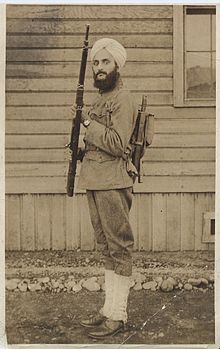Bhagat Singh Thind | |
|---|---|
 Sergeant Bhagat Singh Thind in US Army uniform during World War I at Camp Lewis, Washington, in 1918. Thind, an American Sikh, was the first US serviceman to be allowed for religious reasons to wear a turban as part of his military uniform. | |
| Born | October 3, 1892 |
| Died | September 15, 1967 (aged 74) |
| Citizenship | British Indian (1892–1918) American (1918–1967) |
| Occupation | Writer |
| Known for | United States v. Bhagat Singh Thind |
| Spouse(s) | Chint Kaur Inez Buelen
(m. 1923; div. 1927)Vivian Davies (m. 1940) |
Bhagat Singh Thind (October 3, 1892 – September 15, 1967) was an Indian American writer and lecturer on spirituality who served in the United States Army during World War I and was involved in a Supreme Court case over the right of Indian people to obtain United States citizenship. He was among a group of men of Indian ancestry who attempted to claim he was White and naturalize under federal naturalization law.[2]
Thind enlisted in the United States Army a few months before the end of World War I. After the war he sought to become a naturalized citizen, following a legal ruling that Caucasians had access to such rights. Identifying himself as an Aryan, in 1923, the Supreme Court ruled against him in the case United States v. Bhagat Singh Thind, which retroactively denied all Indian Americans the right to obtain United States citizenship for failing to meet the definition of a "white person", "person of African descent", or "alien of African nativity".[3][4]
Thind remained in the United States, earned his PhD in theology and English literature at UC Berkeley, and delivered lectures on metaphysics. His lectures were based on Sikh religious philosophy, but included references to the scriptures of other world religions and the works of Ralph Waldo Emerson, Walt Whitman, and Henry David Thoreau. Thind also campaigned for Indian independence from colonial rule.[5] In 1936, Thind applied successfully for US citizenship through the State of New York which had made World War I veterans eligible for naturalization regardless of race.
- ^ Ogden, Johanna. "The Telling Case of Doctor Bhagat Singh Thind" (PDF).
- ^ Dhillon, Hardeep (2023). "The Making of Modern US Citizenship and Alienage: The History of Asian Immigration, Racial Capital, and US Law". Law and History Review. 41 (1): 1–42. doi:10.1017/S0738248023000019. ISSN 0738-2480.
- ^ "United States v. Bhagat Singh Thind, 261 U.S. 204 (1923)". Justia.
- ^ "US v. BHAGAT SINGH THIND". FindLaw.com. Retrieved November 15, 2019.
- ^ Wagner, Ella (November 1, 2021). "Bhagat Singh Thind". National Park Service. Archived from the original on November 2, 2021. Retrieved January 20, 2024.